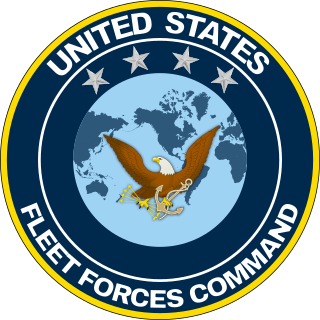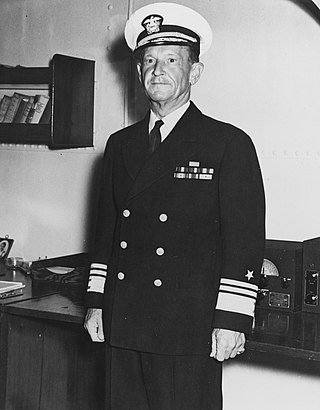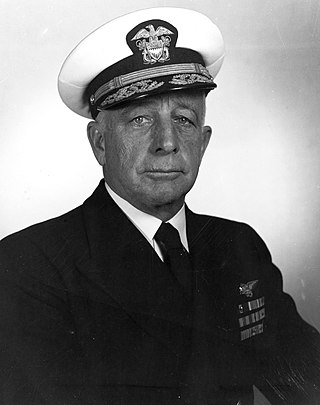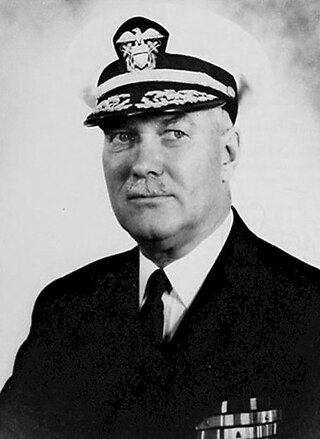Related Research Articles

The United States Pacific Fleet (USPACFLT) is a theater-level component command of the United States Navy, located in the Pacific Ocean. It provides naval forces to the Indo-Pacific Command. Fleet headquarters is at Joint Base Pearl Harbor–Hickam, Hawaii, with large secondary facilities at Naval Air Station North Island, California.

The United States Fleet Forces Command (USFF) is a service component command of the United States Navy that provides naval forces to a wide variety of U.S. forces. The naval resources may be allocated to Combatant Commanders such as United States Northern Command (USNORTHCOM) under the authority of the Secretary of Defense. Originally formed as United States Atlantic Fleet (USLANTFLT) in 1906, it has been an integral part of the defense of the United States of America since the early 20th century. In 2002, the Fleet comprised over 118,000 Navy and Marine Corps personnel serving on 186 ships and in 1,300 aircraft, with an area of responsibility ranging over most of the Atlantic Ocean from the North Pole to the South Pole, the Caribbean Sea, Gulf of Mexico, and the waters of the Pacific Ocean along the coasts of Central and South America.

Frank Jack Fletcher was an admiral in the United States Navy during World War II. Fletcher commanded five different task forces through the war; he was the operational task force commander at the pivotal battles of the Coral Sea and Midway, which collectively resulted in the sinking of five Japanese fleet carriers.

The First Fleet was a numbered fleet of the United States Navy, in operation from January 1947 to 1 February 1973 in the western Pacific Ocean as part of the Pacific Fleet. In 1973, it was disestablished and its duties assumed by the United States Third Fleet.
A destroyer squadron is a naval squadron or flotilla usually consisting of destroyers rather than other types of vessel. In some navies other vessels, such as frigates, may be included. In English the word "squadron" tends to be used for larger and "flotilla" for smaller vessels; both may be used for destroyer units. Similar formations are used in non-English-speaking countries, e.g., the "escadrille"—which would translate directly as "squadron"—in France.

Admiral Richmond Kelly Turner, commonly known as Kelly Turner, was an admiral of the United States Navy during the Second World War, where he commanded the Amphibious Force in the Pacific theater. Turner was also responsible for the creation of the Underwater Demolition Teams (UDT) in 1942 that were an early precursor to the United States Navy SEALs.

Aubrey Wray Fitch was an admiral of the United States Navy during World War II. A naval aviator, he held important aviation-related commands both at sea and on shore from the 1920s onward. He also served as superintendent of the United States Naval Academy.

Pacific Ocean Areas was a major Allied military command in the Pacific Ocean theater of World War II. It was one of four major Allied commands during the Pacific War and one of three United States commands in the Asiatic-Pacific Theater. Admiral Chester W. Nimitz of the U.S. Navy, Commander in Chief, U.S. Pacific Fleet, headed the command throughout its existence.

Walden Lee "Pug" Ainsworth was an admiral of the United States Navy. For his role in commanding destroyer and cruiser task forces in the Pacific during World War II, he was awarded the Navy Cross, the Navy Distinguished Service Medal, and the Legion of Merit.

Robert Carlisle Giffen was an admiral in the United States Navy.

Robert Alfred Theobald, nicknamed "Fuzzy", was a United States Navy officer who served in World War I and World War II, and achieved the rank of rear admiral. In retirement, he was the author of the 1954 book The Final Secret of Pearl Harbor: The Washington Background of the Pearl Harbor Attack.
Service Force, United States Pacific Fleet, usually known as COMSERVPAC, was a service support command of the United States Pacific Fleet from 1942 until 1973. It was the reincarnation of the former Base Force. The Service Force comprised the supply train of the fleet which includes Oilers (AO), Gasoline Tanker (AOG), Repair Ships (AR), Ammunition Ships (AE), Destroyer Tenders (AD) and Submarine tenders (AS).

Rear Admiral Thomas John Ryan, Jr. was a career American naval officer who received the Medal of Honor, the United States' highest military decoration, for his actions while in Yokohama, Japan during the 1923 Great Kantō earthquake. Ryan went on to serve in World War II as a destroyer flotilla commander.
Vice Admiral Ferdinand Louis Reichmuth was an officer of the United States Navy who served in World War I and World War II.

The Eastern Fleet, later called the East Indies Fleet, was a fleet of the Royal Navy which existed between 1941 and 1952.

Benedict Joseph Semmes Jr. was a vice admiral of the United States Navy. His career included service in World War II and the Cold War, command of destroyers, a lengthy tour as Chief of Naval Personnel, command of the United States Second Fleet, duty as Deputy Chief of Naval Operations, and a tour as President of the Naval War College.
The Commander, Battleship Force, Pacific Fleet (COMBATPAC) was the title, from 1922 to 1944, of the United States Navy officer who commanded the battleships of the larger United States Battle Fleet in the Pacific.
The Commander in Chief, Dover was an operational commander of the Royal Navy. His subordinate units, establishments, and staff were sometimes informally known as the Dover Command.
A type commander in the Kriegsmarine was a permanently assigned administrative officer in the organization of the Kriegsmarine which oversaw the development, deployment, and in some cases operational activities of the various classes of German naval vessels. Due to cross jurisdiction with the Navy group commanders, who tactically commanded all vessels at sea, some type commanders were little more than ceremonial officers who held a title with little authority. Others, such as Karl Dönitz who commanded the German U-boat force, exercised near total independence and held enormous authority, both operationally and administrative.